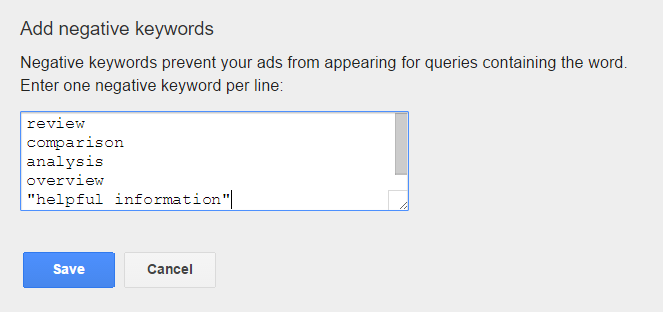Advertisers using Remarketing Lists for Search Ads (RLSA) benefit from targeting and adjusting search network keyword bids for users who previously spent time on their website, without experiencing display network drawbacks.
While the two may sound nearly identical – with the only difference being: display network remarketing involves banner ads rather than text ads – they’re really not. One is killer crafty. The other, conveniently creepy.
Think of a well-dressed, well-groomed man. Not necessarily me, but hey if it helps, go for it. 🙂 Now, imagine observing him in two different settings: at a professional networking event and on Tinder. Pretty different reaction, right? In the first scenario, the man embodies approachability, professionalism, and a mature sense of knowing one’s audience. The later elicits images of red flashing alarms, screams “totes creepy”, triggers all variations of gender-based intuition, and often contributes to a swipe of the left variety. While the man may have the same approach, attitude, and goal in both settings, it’s clear that his outcome will vary.
Well, guess what… So too will remarketing results, if one doesn’t account for audience setting, experience, and perception, by exploring options on the search side of Google’s network.
Remarketing lists used with the search network, deliver results in an appropriate setting to an appropriate audience that is (A) looking for a specific product and (B) unaware of remarketing tactics. Conversely, with Google’s display network reaching 90% of the internet users worldwide, one would be hard-pressed to find many who haven’t experienced display remarketing. When you see it, you know it. You may not like it, swipe – I mean “click” – it, or respect him – I mean “it”, but you know it.

To be fair, there are several scenarios that call for and are aided by display network remarketing. To be double-fair, there are also a variety of benefits associated with Tinder. Both are great for enhancing brand awareness, be it introducing a new logo, re-emphasizing a particular campaign, or just making sure all ladies within 5 miles appreciate your level of rugged sophistication as evidenced by the slightly unbuttoned dress shirt underneath a professional (but not too professional) navy blue coat. Display advertisers can also take advantage of remarketing specific goods or services by reminding ecommerce shoppers of their half-filled and unprocessed carts. Tinder hopefuls unfortunately need to make first impressions (really) count. 🙁
Similar to those at a late night networking event, remarketing through the search network offers an opportunity for hyper-focused stealth marketing, applicable to any advertiser. Just as the professionally intermingled might question whether the person standing before them is trying to expand his/her network, get a job, or make a personal connection, so too are those using the search network unable to differentiate ads that are influenced by remarketing from those that are not. As far as they know, ads are appearing solely due to search term relevance. Instead of putting a product or brand in front of display website, video, or blog viewers (who are increasingly aware of obvious remarketing tactics), consider using remarketing lists to enhance search network presence and remind familiar followers that it belongs in the conversion conversation.
In this (re)marketing world of attraction, implementing an RLSA could be a game changer for those looking to…
Target past site viewers
Re-engage users who are actively searching and in the final stages of a sales cycle by using RLSA in tandem with (A) keywords matching the particular product or category and (B) exclusions of obvious initial-to-mid sales cycle keywords, like “review” and “comparison”.
Every good networker knows that to be effective, one needs to prioritize the room and hunt highly-valued opportunities first. Because really, no one should be pitching A-listers after three hours of handshaking, listening, talking, nerve-racing, and drinking (to take care of those nerves, obviously). RLSA allows advertisers to prioritize search visitors and attack when most profitable.
If lead-gen is a KPI, try increasing bids on high-value audiences who have engaged with the site but never submitted a form. Got a list of chronic window shoppers or premature evacuators? Layer on a positive bid modifier to send a gentle reminder that a lonely, partially-filled cart awaits them! Conversely, bids can be decreased on lower value audiences, like those that have already made a purchase or opted to download within a given time-frame.
Remarket in a not-so-obvious way
When appearing in the search network, an ad will not trigger the same “Ohhhh I know why I’m seeing this… very sneaky…” reaction as it might with increasingly savvy display network-ers. Instead, it will be viewed as a serious contender amongst the other fine (but far less superior) options that Google presents.
Get in front of non-committal comparison shoppers by bidding on competitor terms using RLSA. This way, an advertiser can adjust bids on competition-friendly keywords when the user has already touched a given site (aka, the advertiser is a contender for a sale!).
Tailoring ad messaging based on page/site engagement is a clever way to intrigue a user while boosting chances of a conversion. If a dress retailer has lists of visitors who have spent over ten minutes on wedding dress pages, and have been on the site over three times in the past few months, it would be wise to tailor ad creative to speak to them. Acknowledge that the struggle is real. Provide a deal. At the end of the day, approaching each messaging strategy as a human being rather than a business may be the best possible move.
Test expansion while minimizing risk
Thinking of using a new keyword group and interested in limiting the audience for an initial “test run”? Then consider testing it with site regulars. If it doesn’t produce positive results with all-star viewers, it’s unlikely that it’ll work with an inexperienced audience. If it’s not just keyword exploration being considered, but a new product or product line, a soft run aimed at past purchasers or high engagers, would be an excellent use of RLSA. Already selling kitchen knives and want to take a stab at the cutting board industry (pun intended)? Test ad performance on those who have already purchased cutlery to get a glimpse of market demand.
Justify entering expensive/generic spaces
Does the average CPC/CPA deter bidding on certain keywords? Using RLSA in tandem with generic or expensive terms can offset paying a premium, since the auction space consists of individuals already familiar with the given brand/product and are more likely to convert.
Additionally, take the art of qualification one step further by creating remarketing lists using social psychographic audience targeting. Looking to target high purchase power IT pros who work at companies with $1B+ net worth? First, create and launch desired audiences in social and create remarketing lists in AdWords/Analytics. To build cookie pools large enough for RLSA, an investment of time or money will be needed initially. Once cookie pools have garnered enough visitors, launch generic/”premium” keyword lists in Search, and voila: An advertiser is able to capture high-intent traffic in Search through Social behavioral, demographic, interest, and third-party targeting data.
With these fantastic, creatively-stimulating suggestions and the endless array of possibilities they inspire come two points that all advertisers should consider. First, at least 1,000 unique members are required in a remarketing list before one is able to start implementing an RLSA. Don’t have time to wait for that list to build? Additional funds will need to be invested to drive site traffic. Second, it is paramount that advertisers put thoughtful consideration into messaging strategy before launching an RLSA campaign. No one would approach a valued contact while networking without a pitch and plan of action in mind, so don’t try here. Expertly craft, review, and rewrite individual messages AND understand the entire messaging sequence from the start. It could be the difference between success and failure.
Through RLSA, advertisers may refine campaign strategy and nurture symbiotic relationships between user perception, audience experience, and business objectives. Attain knowledge and plan accordingly. Mastering the art of impression management (both first and subsequent) is key to remarketing success. Explore RLSA to increase odds, enhance ads, and get killer crafty in lieu of conveniently creepy. It may not only improve results metrics, but confidence, pride, and swipe-right-ratios (SRR) as well.















